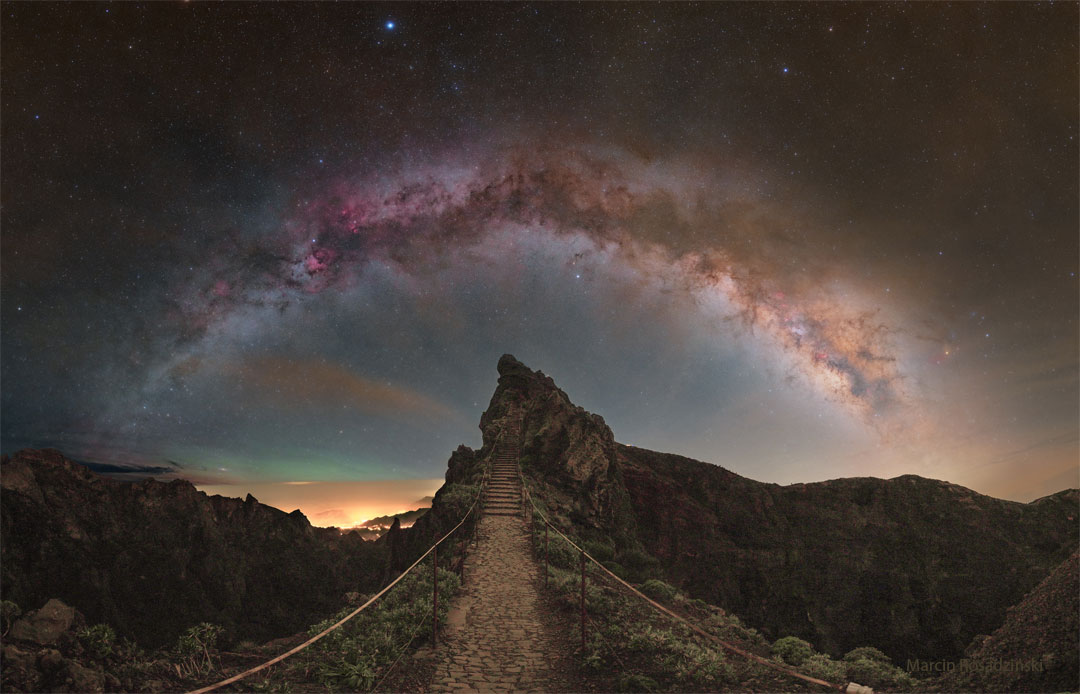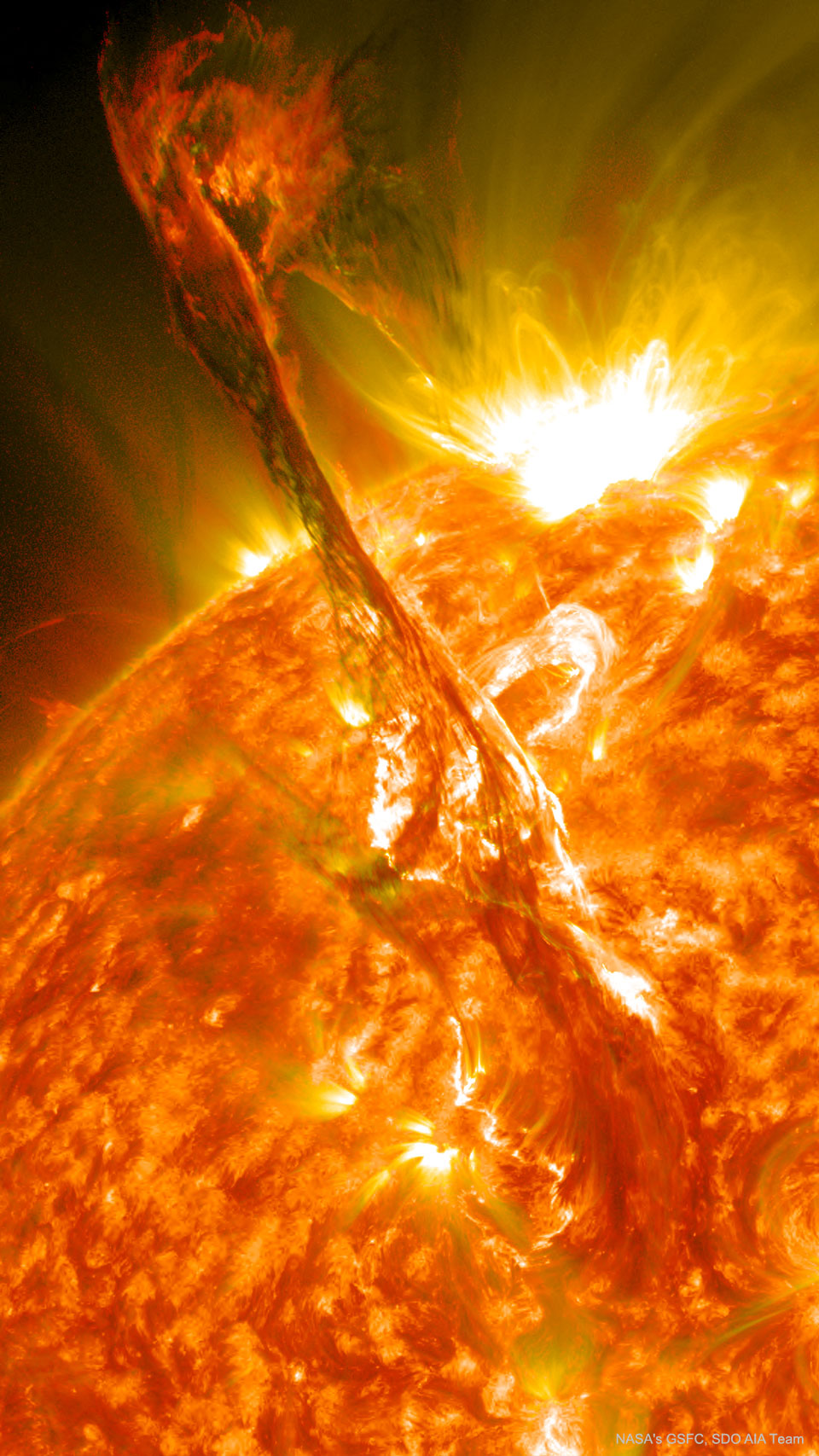Nombre total de pages vues
29/05/2024
NUCLEAIRE - Comment survivre à une explosion nucléaire ? Scellez et jetez vos vêtements
ASTRONOMY - Stairway to the Milky Way
2024 May 29
Image Credit & Copyright: Marcin Rosadziński
Explanation: What happens if you ascend this stairway to the Milky Way? Before answering that, let's understand the beautiful sky you will see. Most eye-catching is the grand arch of the Milky Way Galaxy, the band that is the central disk of our galaxy which is straight but distorted by the wide-angle nature of this composite image. Many stars well in front of the Milk Way will be visible, with the bright white star just below the stellar arch being Altair, and the bright blue star above it being Vega. The air glows green on the left, just above the yellow cloud deck. The featured image was taken last month on Portugal's Madeira Island in the North Atlantic Ocean. Oh, and what happens after you reach the top of these stairs and admire the amazing sky is, quite probably, that you then descend down the stairs on the other side.
28/05/2024
ASTRONOMY - Solar X Flare as Famous Active Region Returns
2024 May 28
Video Credit: NASA, Solar Dynamics Observatory
Explanation: It's back. The famous active region on the Sun that created auroras visible around the Earth earlier this month has survived its rotation around the far side of the Sun -- and returned. Yesterday, as it was beginning to reappear on the Earth-facing side, the region formerly labeled AR 3664 threw another major solar flare, again in the highest-energy X-class range. The featured video shows the emerging active region on the lower left, as it was captured by NASA's Earth-orbiting Solar Dynamics Observatory yesterday in ultraviolet light. The video is a time-lapse of the entire Sun rotating over 24 hours. Watch the lower-left region carefully at about the 2-second mark to see the powerful flare burst out. The energetic particles from that flare and associated CME are not expected to directly impact the Earth and trigger impressive auroras, but scientists will keep a close watch on this unusually active region over the next two weeks, as it faces the Earth, to see what develops.
NUCLEAIRE - Comment survivre à une explosion nucléaire ? Retirez vos vêtements contaminés
27/05/2024
ASTRONOMY - Chamaeleon I Molecular Cloud
2024 May 27
Image Credit & Copyright: Amiel Contuliano
Explanation: Dark markings and bright nebulae in this telescopic southern sky view are telltale signs of young stars and active star formation. They lie a mere 650 light-years away, at the boundary of the local bubble and the Chamaeleon molecular cloud complex. Regions with young stars identified as dusty reflection nebulae from the 1946 Cederblad catalog include the C-shaped Ced 110 just above and right of center, and bluish Ced 111 below it. Also a standout in the frame, the orange tinted V-shape of the Chamaeleon Infrared Nebula (Cha IRN) was carved by material streaming from a newly formed low-mass star. The well-composed image spans 1.5 degrees. That's about 17 light-years at the estimated distance of the nearby Chamaeleon I molecular cloud.
NUCLEAIRE - Comment survivre à une explosion nucléaire ? Les premières 24 heures: prenez une douche et restez à l'intérieur
26/05/2024
SANTé/MEDECINE - Virus et bactéries mortels - Ebola : le virus à la mortalité la plus élevée ?
NUCLEAIRE - Comment survivre à une explosion nucléaire ? Les bâtiments sur plusieurs étages
ASTRONOMY - A Solar Filament Erupts
2024 May 26
Image Credit: NASA's GSFC, SDO AIA Team
Explanation: What's happened to our Sun? Nothing very unusual -- it just threw a filament. Toward the middle of 2012, a long standing solar filament suddenly erupted into space, producing an energetic coronal mass ejection (CME). The filament had been held up for days by the Sun's ever changing magnetic field and the timing of the eruption was unexpected. Watched closely by the Sun-orbiting Solar Dynamics Observatory, the resulting explosion shot electrons and ions into the Solar System, some of which arrived at Earth three days later and impacted Earth's magnetosphere, causing visible auroras. Loops of plasma surrounding the active region can be seen above the erupting filament in the featured ultraviolet image. Our Sun is nearing the most active time in its 11-year cycle, creating many coronal holes that allow for the ejection of charged particles into space. As before, these charged particles can create auroras.
25/05/2024
NUCLEAIRE - Comment survivre à une explosion nucléaire ? Les abris idéaux
ASTRONOMY - The Observable Universe
2025 November 23 The Observable Universe Illustration Credit & Licence : Wikipedia , Pablo Carlos Budassi Explanation: How far can ...

-
2022 September 26 All the Water on Planet Earth Illustration Credit: Jack Cook, Adam Nieman, Woods Hole Oceanographic Institution ; Data ...
-
2025 May 11 The Surface of Venus from Venera 14 Image Credit: Soviet Planetary Exploration Program , Venera 14 ; Processing & Copyri...








